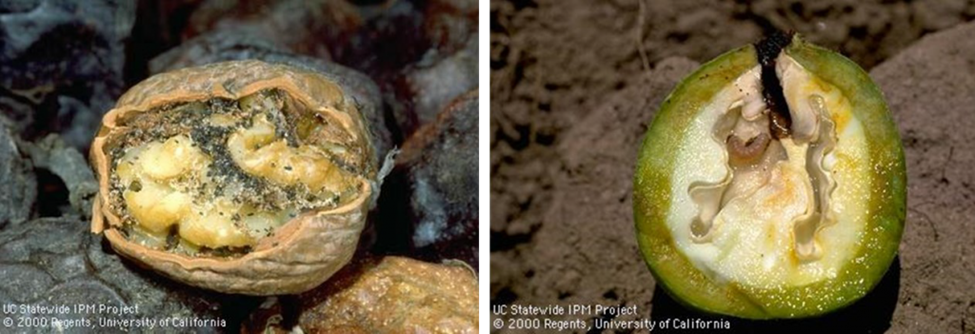Sudan Gyawaly, UCCE IPM Advisor, Butte, Colusa, Sutter-Yuba, Glenn, and Tehama Counties
Jhalendra Rijal, UCCE IPM Advisor, Stanislaus, Merced & San Joaquin Counties
1. In-season NOW Management
Navel orangeworm is a pest remaining on most nut growers’ and pest control advisors’ minds regardless of the time of the year. There is always room for improving IPM, including adopting effective winter sanitation, implementing a season-long monitoring program, deploying mating disruption tools, spraying insecticides, and performing timely harvest.
a. Pre-husk-split consideration:
NOW larvae cannot infest healthy, intact walnuts; however blighted, sunburnt, and codling moth-infested nuts can be infested by NOW. Such nuts provide suitable egg laying and larval development sites allowing NOW to build up prior to hull split. Therefore, practices minimizing the number of NOW susceptible nuts during the growing season can go a long way toward reducing NOW damage risks. As important as some of these practices are to minimize NOW damage, we are almost too late to use these methods for this season. Tactics still ahead and outlined below need to be incorporated for sustainable NOW management in walnuts.
b. Post-husk-split considerations:
Walnuts generally become susceptible to NOW at husk split. NOW can feed and survive on many other host plants, mainly other tree nuts – almond and pistachio. NOW can fly from one orchard to another depending on the presence and susceptibility of the hosts. Therefore, we must keep monitoring NOW populations to make pesticide application decisions. Walnuts are at greatest risk at husk split, and all walnut varieties are susceptible at that stage.
Assessing the nut susceptible stage (husk-split) and moth activity (adult flight, egg laying, etc.) is most critical in deciding the need for and timing of insecticide application. If you have been following your pheromone and egg trap counts, the NOW population increases exponentially as the number of generations increases. Walnuts are at higher risk by the 3rd – 4th NOW moth flights when early or late maturing varieties are typically at husk-split. Moreover, late walnut varieties are at greater risk of NOW damage because almonds, the most common alternate host, are already harvested. Your pest control adviser or crop consultant can help you decide if an insecticide treatment at husk-split is needed.
Early harvest, or more precisely “timely harvest,” is one of the important ways to reduce NOW damage in walnuts. One more thing worth considering, particularly if you have high NOW pressure, is the application of ethephon. Ethephon expedites husk split and helps synchronize an early harvest. Ethephon application allows harvesting walnuts at least 7-10 days earlier than normal and can reduce the risk of NOW damage. More information on ethephon use is available at UC IPM.
2. Post-harvest NOW Management
a. Harvest damage evaluation:
In-field harvest samples are vital since through sample evaluation they can determine the source of damage, help assess the current year’s IPM program, and help in planning for next year’s IPM program.
Collect at least 1,000 nuts from each block for harvest sampling. The sample should represent the whole block. For insect damage evaluation, collect 100 nut samples per bag and ten bags representing the different parts of the block. NOW damaged walnuts can be differentiated from codling moth damage, by the absence of entry holes on the husk, presence of a large amount of frass and webbing in the kernel, and presence of often many larvae in the kernel. The details on harvest sampling and sample evaluation are available in another article at SacValleyOrchards.
b. Orchard sanitation:
Winter orchard sanitation is the foundation of NOW management because it minimizes the ‘within orchard’ NOW population and lowers the risk of NOW damage in the coming season. Dry winters make winter sanitation more crucial since they favor higher NOW over-wintering survival. NOW larvae overwinter in leftover ‘mummy’ nuts in trees and trash nuts on the orchard floor, uncleaned harvesting equipment, and other facilities and processing plants around the field.
Keep orchards, equipment, and facilities adjacent to the orchard as free of mummy nuts as possible. If the orchard has high NOW infestation, this is vital to reduce the NOW pressure. Clean up mummy nuts any time after harvest but be sure to complete the job by mid-March at the latest. Wait until a rainstorm or 1-2 wet/foggy days before a mummy shake as wet conditions facilitate easier nut removal compared to dry conditions. Hand poles can also be used to remove mummy nuts from trees, unfortunately hand poling crews come at significant cost. Once on the orchard floor, mummy nuts should be swept into rows and flail mowed.



Leave a Reply